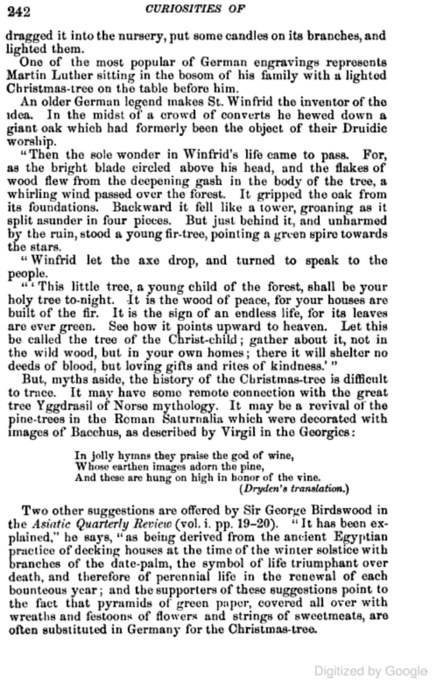Searching for "evergreen tree which sprang out of a dead tree stump" gets nearly 3000 hits.
The Seed of the Woman and the Power of Darkness - Donbor Syiemlieh - Google Books is an example:
"An old Babylonish fable told of an evergreen tree which sprang out of a dead tree stump. The old stump symbolized the dead Nimrod, the new evergreen tree symbolized that Nimrod had come to life again in Tammuz! Among the Druids the oak was sacred, among the Egyptians it was the palm, and in Rome it was the fir, which was decorated with red berries during the Saturnalia!" (Walsh, Curiosities of Popular Customs, p. 242).
Obviously I didn't check all results, but those that I did check contain that same quotation, and almost all give the same attribution.
The problem is, while page 242 of that book does talk about Christmas trees, and the writing style is similar, it doesn't include the above quotation or anything like it:
242 CURIOSITIES OF
dragged it into the nursery, put some candles on its branches, and lighted them.
One of the most popular of German engravings represents Martin Luther sitting in the bosom of his family with a lighted Christmas-tree on the table before him.
An older German legend makes St. Winfrid the inventor of the idea. In the midst of a crowd of converts he hewed down a giant oak which had formerly been the object of their Druidie worship.
"Then the sole wonder in Winfrid's life came to pass. For, as the bright blade circled above his head, and the flakes of wood flew from the deepening gash in the body of the tree, a whirling wind passed over the forest. It gripped the oak from its foundations. Backward it fell like a tower, groaning as it split asunder in four pieces. But just behind it, and unharmed by the ruin, stood a young fir-tree, pointing a green spire towards the stars.
"Winfrid let the axe drop, and turned to speak to the people.
"This little tree, a young child of the forest, shall be your holy tree to-night. It is the wood of peace, for your houses are built of the fir. It is the sign of an endless life, for its leaves are ever green. See how it points upward to heaven. Let this be called the tree of the Christ-child; gather about it, not in the wild wood, but in your own homes; there it will shelter no deeds of blood, but loving gifts and rites of kindness." "
But, myths aside, the history of the Christmas-tree is difficult to trace. It may have some remote connection with the great tree Yggdrasil of Norse mythology. It may be a revival of the pine-trees in the Roman Saturnalia which were decorated with images of Bacchus, as described by Virgil in the Georgies:
In jolly hymns they praise the god of wine, Whose earthen images adorn the pine, And these are hung on high in honor of the vine. — (Dryden's translation.)
Two other suggestions are offered by Sir George Birdswood in the Asiatic Quarterly Review (vol. i. pp. 19-20). "It has been ex- plained," he says, "as being derived from the ancient Egyptian practice of decking houses at the time of the winter solstice with branches of the date-palm, the symbol of life triumphant over death, and therefore of perennial life in the renewal of each bounteous year; and the supporters of these suggestions point to the fact that pyramids of green paper, covered all over with wreaths and festoons of flowers and strings of sweetmeats, are often substituted in Germany for the Christmas-tree.
The quotation doesn't appear elsewhere in that section or anywhere else in the book.
So what is its origin?
